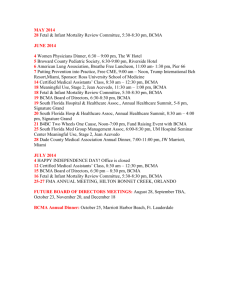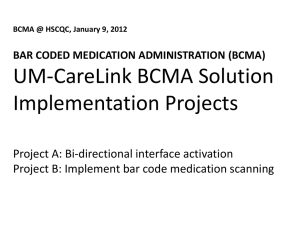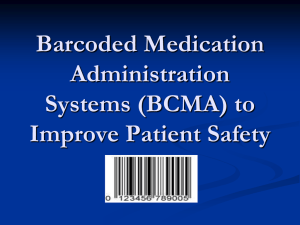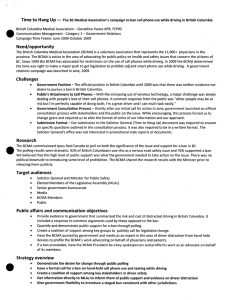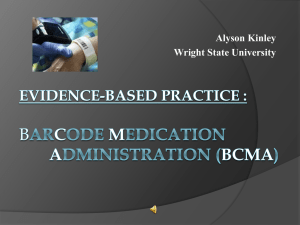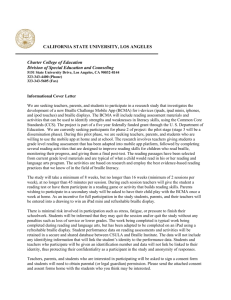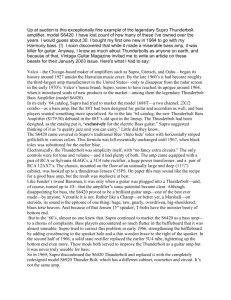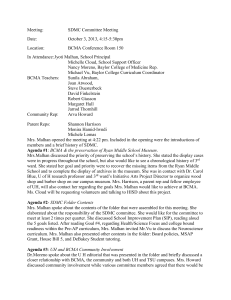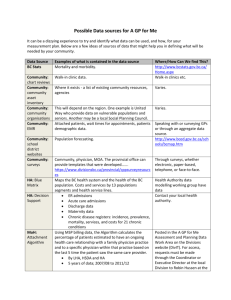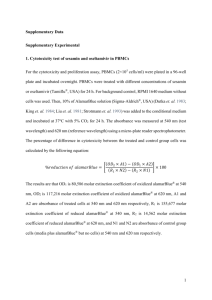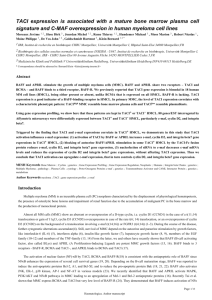Designing APRIL-Based Therapeutics for
advertisement
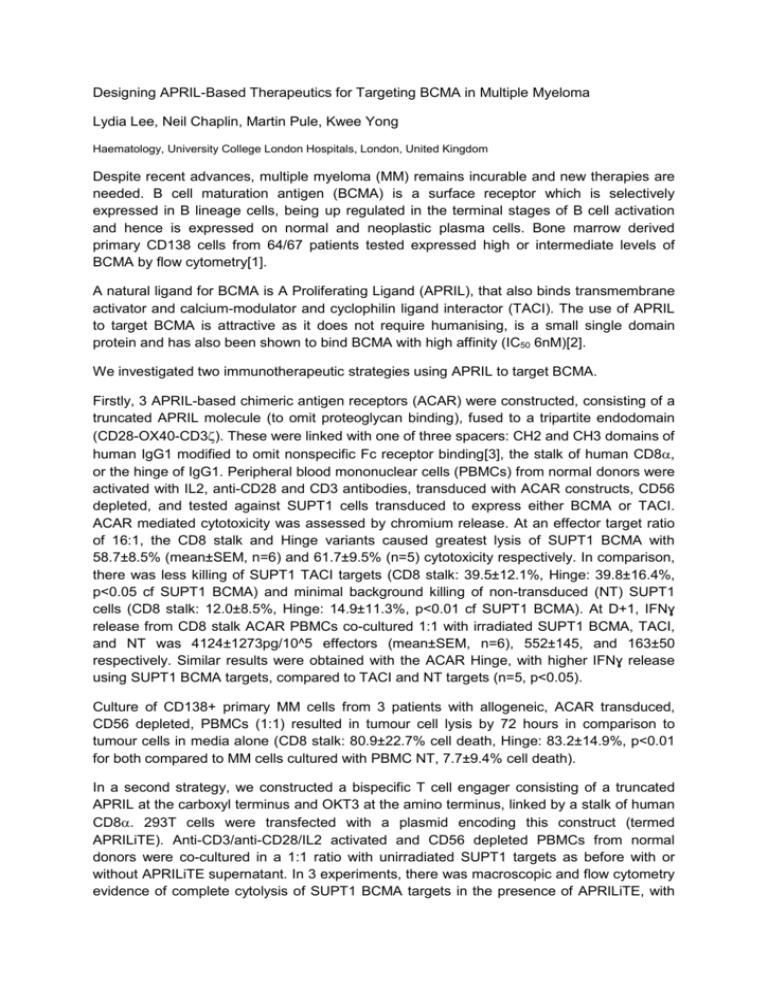
Designing APRIL-Based Therapeutics for Targeting BCMA in Multiple Myeloma Lydia Lee, Neil Chaplin, Martin Pule, Kwee Yong Haematology, University College London Hospitals, London, United Kingdom Despite recent advances, multiple myeloma (MM) remains incurable and new therapies are needed. B cell maturation antigen (BCMA) is a surface receptor which is selectively expressed in B lineage cells, being up regulated in the terminal stages of B cell activation and hence is expressed on normal and neoplastic plasma cells. Bone marrow derived primary CD138 cells from 64/67 patients tested expressed high or intermediate levels of BCMA by flow cytometry[1]. A natural ligand for BCMA is A Proliferating Ligand (APRIL), that also binds transmembrane activator and calcium-modulator and cyclophilin ligand interactor (TACI). The use of APRIL to target BCMA is attractive as it does not require humanising, is a small single domain protein and has also been shown to bind BCMA with high affinity (IC50 6nM)[2]. We investigated two immunotherapeutic strategies using APRIL to target BCMA. Firstly, 3 APRIL-based chimeric antigen receptors (ACAR) were constructed, consisting of a truncated APRIL molecule (to omit proteoglycan binding), fused to a tripartite endodomain (CD28-OX40-CD3). These were linked with one of three spacers: CH2 and CH3 domains of human IgG1 modified to omit nonspecific Fc receptor binding[3], the stalk of human CD8, or the hinge of IgG1. Peripheral blood mononuclear cells (PBMCs) from normal donors were activated with IL2, anti-CD28 and CD3 antibodies, transduced with ACAR constructs, CD56 depleted, and tested against SUPT1 cells transduced to express either BCMA or TACI. ACAR mediated cytotoxicity was assessed by chromium release. At an effector target ratio of 16:1, the CD8 stalk and Hinge variants caused greatest lysis of SUPT1 BCMA with 58.7±8.5% (mean±SEM, n=6) and 61.7±9.5% (n=5) cytotoxicity respectively. In comparison, there was less killing of SUPT1 TACI targets (CD8 stalk: 39.5±12.1%, Hinge: 39.8±16.4%, p<0.05 cf SUPT1 BCMA) and minimal background killing of non-transduced (NT) SUPT1 cells (CD8 stalk: 12.0±8.5%, Hinge: 14.9±11.3%, p<0.01 cf SUPT1 BCMA). At D+1, IFNɣ release from CD8 stalk ACAR PBMCs co-cultured 1:1 with irradiated SUPT1 BCMA, TACI, and NT was 4124±1273pg/10^5 effectors (mean±SEM, n=6), 552±145, and 163±50 respectively. Similar results were obtained with the ACAR Hinge, with higher IFNɣ release using SUPT1 BCMA targets, compared to TACI and NT targets (n=5, p<0.05). Culture of CD138+ primary MM cells from 3 patients with allogeneic, ACAR transduced, CD56 depleted, PBMCs (1:1) resulted in tumour cell lysis by 72 hours in comparison to tumour cells in media alone (CD8 stalk: 80.9±22.7% cell death, Hinge: 83.2±14.9%, p<0.01 for both compared to MM cells cultured with PBMC NT, 7.7±9.4% cell death). In a second strategy, we constructed a bispecific T cell engager consisting of a truncated APRIL at the carboxyl terminus and OKT3 at the amino terminus, linked by a stalk of human CD8. 293T cells were transfected with a plasmid encoding this construct (termed APRILiTE). Anti-CD3/anti-CD28/IL2 activated and CD56 depleted PBMCs from normal donors were co-cultured in a 1:1 ratio with unirradiated SUPT1 targets as before with or without APRILiTE supernatant. In 3 experiments, there was macroscopic and flow cytometry evidence of complete cytolysis of SUPT1 BCMA targets in the presence of APRILiTE, with lesser killing of SUPT1 TACI targets. Co-culture of activated PBMCs with SUPT1 BCMA and APRILiTE also resulted in high IFNɣ release (3526±1202pg/10^5 effectors, n=3), with markedly lower levels seen using SUPT1 TACI targets (830±508, p<0.05), or SUPT1 NT targets (11.0±6.4, p<0.01). A second APRILiTE construct with the antigen binding site at inverted termini produced similar levels of target cell death and IFNɣ release. The activity of APRILiTE was tested against primary CD138+ MM cells from 2 patients using allogeneic PBMCs. After 72 hours of co-culture with APRILiTE (1:1) there was 63.5% and 96.9% loss of CD138+ cells compared to co-culture of tumour cells, PBMCs and media alone. The presence of APRILiTE also resulted in increased levels of IFNɣ release (p<0.05 compared to media control). In conclusion, we report two novel and potent immunotherapeutic strategies to target BCMA using its natural ligand, APRIL. Both ACAR and APRILiTE demonstrated higher activity against BCMA targets compared to TACI targets. These promising APRIL based therapeutics are currently being further refined and investigated for the treatment of myeloma. 1. 2. 3. Yong, K.L., et al., Evaluation Of Bcma As a Therapeutic Target In Multiple Myeloma Using An Antibody-Drug Conjugate. ASH abstract, 2013. Patel, D.R., et al., Engineering an APRIL-specific B cell maturation antigen. J Biol Chem, 2004. 279(16): p. 16727-35. Hombach, A., A.A. Hombach, and H. Abken, Adoptive immunotherapy with genetically engineered T cells: modification of the IgG1 Fc 'spacer' domain in the extracellular moiety of chimeric antigen receptors avoids 'off-target' activation and unintended initiation of an innate immune response. Gene Ther, 2010. 17(10): p. 1206-13.
